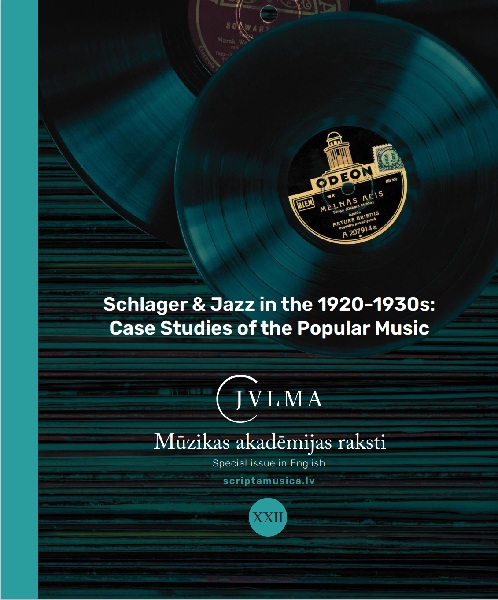JAZZ AND POPULAR MUSIC IN ESTONIAN PERIODICALS IN THE 1920s AND 1930
Keywords:
Popular music studies, jazz, Estonian journalism, databases, content analysisAbstract
This article aims to analyse the coverage of jazz and popular music in Estonian periodicals (such as the daily newspaper Päewaleht) in the 1920s and 1930s – a task facilitated by their inclusion in full-text databases (dea.digar.ee). In Section 1, a short overview of jazz and popular music in Estonia in that period is provided. The word “jazz” could be encountered in a variety of journalistic contexts, ranging from essays on modern culture to gossip and advertisements. In Section 2, I will describe how databases such as dea.digar.ee allow the use of quantitative methods of content analysis by means of which the number of occurrences of a musical term (“jazz”, “tango”, or “the Charleston”) in a certain period can be determined. Although not all the miscellaneous mentions of jazz in periodicals are musically insightful, they nevertheless speak aptly for the status that jazz music had as a symbol of “the modern way of life” (Section 3).
Downloads
References
PERIODICALS
Ajaleht (1913), Feuilleton-Beilage der Revalschen Zeitung (1911), Kirjandus. Kunst. Teadus (1922), Muusikaleht (1925), Postimees (1931–1932), Päewaleht (1924–1927, 1931–1932), Raadioleht (1931), Sakala (1929), Tallinna Teataja (1919, 1921).
LITERATURE
Cohen, Gerald Leonard (2015). Origin of the Term “Jazz”. Rolla: Missouri University of Science & Technology
Crease, Robert P. (2000). Jazz and Dance.The Oxford Companion to Jazz. Bill Kirchner (Ed.). Oxford. Oxford University Press, pp. 696–705.
Currell, Susan (2009). American Culture in the 1920s. Edinburgh: Edinburgh University Press.
Hennoste, Tiit, Roosmarii Kurvits (2019). Eesti ajakirjanduse 100 aastat [100 Years of Estonian Journalism]. Tallinn: Post Factum.
Hovi, Kalervo (2017). Kuld Lõwi ja Kultase ajal: Tallinna restoranikultuuri ajalugu 1918–1940 [The time of Kuld Lõwi Restaurant and Kultas Café: The History of Restaurant Culture in Tallinn 1918–1940]. Translated from Finnish by Piret Saluri. Tallinn: Varrak.
Hullot-Kentor, Robert (2009). Introduction. – Theodor W. Adorno. Current of Music. Elements of a Radio Theory. Edited with an Introduction by Robert Hullot-Kentor, Cambridge: Polity Press, pp. 1–40.
Knowles, Mark (2009). The Wicked Waltz and Other Scandalous Dances: Outrage at Couple Dancing in the 19th and Early 20th Centuries. Jefferson (N.C.); London: McFarland.
Lauk, Tiit (2010). Džäss Eestis 1918–1945 [Jazz in Estonia in 1918–1945]. Tallinn: Argo.
Leivategija, Karin (2023). ‘Dance is a disease for us’: dancing through the night as a threat to moral order in urbanizing Estonia. – Urban History, First View, 1 – 22.
Neuendorf, Kimberly A. (2017). The Content Analysis Guidebook. 2nd edition. Thousand Oaks: Sage.
Ojakäär, Valter (2000). Vaibunud viiside kaja. Eesti levimuusika ajaloost [The Echo of Faded Tunes. On the History of Estonian Popular Music]. Volume 1. Tallinn: Eesti Entsüklopeediakirjastus.
Ramul, Peeter (1925). Mõni sõna modernismist muusikas [Some Words on Modernism in Music]. – Muusikaleht, 1925, No.2, 24–25.
Reimann, Heli (2013). Jazz Research and the Moments of Change. – Etnomusikologian vuosikirja, Vol. 25, 8–33.
Tool, Aare (2023). Theodor W. Adorno raadioteooria: tõlgenduskatse Eesti vaatenurgast 1920. ja 1930. aastatel [Theodor W. Adorno’s Radio Theory: An Interpretation from the Estonian Perspective of the 1920s and 1930s]. – Res Musica, No. 15, 123–143.
Veitners, Indriķis (2014). Ārzemju džeza mūziķi Latvijā 20. gadsimta 20.–30. gados [Foreign Jazz Musicians in Latvia up to 1940] – Mūzikas akadēmijas raksti, XI, 88–99.
Downloads
Published
Issue
Section
License
Copyright (c) 2025 Mūzikas akadēmijas raksti

This work is licensed under a Creative Commons Attribution 4.0 International License.


